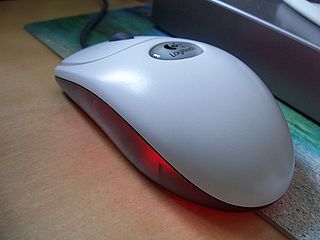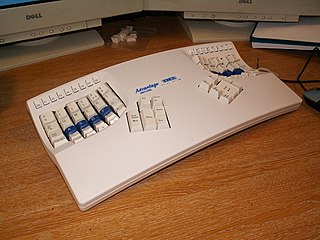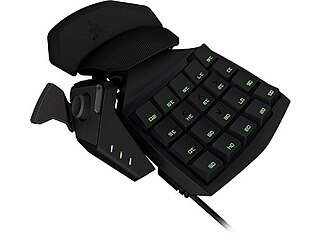

The DataHand is an unconventional computer keyboard introduced in 1990 by DataHand Systems, Inc., designed to be operated without any wrist motion or finger extension. [2]


The DataHand is an unconventional computer keyboard introduced in 1990 by DataHand Systems, Inc., designed to be operated without any wrist motion or finger extension. [2]
DataHand Systems, Inc. was founded in 1985. [3] [4] It was invented by Dale J. Retter and produced as early as 1990. [5]
After the initial prototype was released in 1995, DataHand released the Professional and Professional II models with new bodies. The Professional II also has extended programming capabilities over the Professional, being able to record macros of keystrokes for convenient use.
DataHand Systems, Inc. announced in early 2008 that it was ceasing to sell its keyboards. The company web site states that due to supplier issues, the company will not sell the DataHand keyboard "until a new manufacturer can be identified". In January 2009, the company's website started taking orders for a "limited number of new DataHand Pro II units". Circa 19 April 2010, DataHand were out of stock. [6]
In 2019, a longtime DataHand user going by the pseudonym JesusFreke released an open source DataHand-style device called the lalboard, with plastic parts manufacturable on a home 3D printer, hand-solderable circuit boards, and off-the-shelf magnets. [7] The mechanism is essentially the same as the DataHand, using magnets for key return and optointerrupters to sense the movements of the keys.
In 2023, another longtime DataHand user released a small-run production device called Svalboard, evolving the lalboard design into a manufacturable product. [8]
In 2024, Svalboard launched the Lightly [9] DataHand-style keyboard, which includes trackpoint and trackball pointing device options, as well as a self-print kit [10] for builders who want to make their own.
There is also a Datahand Discord [11] on which Datahand, lalboard and Svalboard users discuss layouts, builds, and other input-related topics. It is the only known gathering place specifically for users of Datahand-style keyboards.
It consists of two separate "keyboards", one for the left hand and one for the right. Each finger activates five buttons: the four compass directions as well as down. [12] The thumbs also have five buttons: one inside, two outside, up and down. [13]
The layout is initially similar to a QWERTY keyboard, but the middle two columns of keys (i.e. H,Y,G...) have been delegated to sideways finger movements, and all of the keys outside of the main three rows are accessed through two additional modes, including a mode for mousing. There are three primary modes all together: letters, number and symbols, and function / mouse mode. Some practice is required. However, eventual typing speedups are possible.[ citation needed ]
Rather than being spring-loaded, the buttons are held in place with magnets and are activated using optical sensors. This was done in order to reduce the finger workload while still giving tactile feedback. The button modules in which the fingers rest are adjustable—each side can be independently moved vertically or forward and back. [14] ".

A keyset or chorded keyboard is a computer input device that allows the user to enter characters or commands formed by pressing several keys together, like playing a "chord" on a piano. The large number of combinations available from a small number of keys allows text or commands to be entered with one hand, leaving the other hand free. A secondary advantage is that it can be built into a device that is too small to contain a normal-sized keyboard.

A pointing device is a human interface device that allows a user to input spatial data to a computer. Graphical user interfaces (GUI) and CAD systems allow the user to control and provide data to the computer using physical gestures by moving a hand-held mouse or similar device across the surface of the physical desktop and activating switches on the mouse. Movements of the pointing device are echoed on the screen by movements of the pointer and other visual changes. Common gestures are point and click and drag and drop.

A wearable computer, also known as a body-borne computer, is a computing device worn on the body. The definition of 'wearable computer' may be narrow or broad, extending to smartphones or even ordinary wristwatches.

A pointing stick is a small analog stick used as a pointing device typically mounted centrally in a computer keyboard. Like other pointing devices such as mice, touchpads or trackballs, operating system software translates manipulation of the device into movements of the pointer on the computer screen. Unlike other pointing devices, it reacts to sustained force or strain rather than to gross movement, so it is called an "isometric" pointing device. IBM introduced it commercially in 1992 on its laptops under the name "TrackPoint", and patented an improved version of it in 1997. It has been used for business laptops, such as Acer's TravelMate, Dell's Latitude, HP's EliteBook and Lenovo's ThinkPad.

Microsoft SideWinder was the general name given to the family of digital game controllers developed by Microsoft for PCs. The line was first launched in 1995. Although intended only for use with Microsoft Windows, Microsoft SideWinder game controllers can also be used with macOS, Mac OS 9 with third-party software, and Linux.
Microsoft has designed and sold a variety of ergonomic keyboards for computers. The oldest is the Microsoft Natural Keyboard, released in 1994, the company's first computer keyboard. The newest models are the Sculpt Ergonomic Keyboard (2013), the Surface Ergonomic Keyboard (2016), and the Microsoft Ergonomic Keyboard (2019).

Caps Lock⇪ Caps Lock is a button on a computer keyboard that causes all letters of bicameral scripts to be generated in capital letters. It is a toggle key: each press reverses the previous action. Some keyboards also implement a light to give visual feedback about whether it is on or off. Exactly what Caps Lock does depends on the keyboard hardware, the operating system, the device driver, and the keyboard layout. Usually, the effect is limited to letter keys. Letters of non-bicameral scripts and non-letter characters are generated normally.
A human interface device or HID is a type of computer device usually used by humans that takes input from or provides output to humans.

Arrow keys or cursor movement keys are keys on a computer keyboard that are either programmed or designated to move the cursor in a specified direction.

Kinesis is a company based near Seattle that offers computer keyboards with ergonomic designs as alternatives to the traditional keyboard design. Most widely known among these are the contoured Advantage line, which features recessed keys in two bucket-like hollows to allow the user's fingers to reach keys with less effort. Moreover, the keys are laid out in perfect vertical rows to avoid the need for lateral movements during typing. In addition, the modifiers such as enter, alt, backspace, control, etc. are moved to a central location so they can be pressed with the stronger thumbs rather than the pinky fingers.
PCD Maltron Ltd, trading as Maltron, is a manufacturer of ergonomic special-needs keyboards. It was founded by South African-born inventor Lillian Malt and manufacturer Stephen Hobday. Maltron specialises in making keyboards for the prevention and etiological treatment of repetitive strain injury.

An ergonomic keyboard is a computer keyboard designed with ergonomic considerations to minimize muscle strain, fatigue, and other problems.

The Microwriter is a hand-held portable word-processor with a chording keyboard. First demonstrated in 1978, it was invented by UK-based, US-born film director Cy Endfield and his partner Chris Rainey and was marketed in the early 1980s by Microwriter Ltd, of Mitcham, Surrey, UK. By using a mnemonic alphabet, its manufacturers stated it allowed note-taking of up to 8,000 characters at an input rate averaging 1.5 times that of handwriting.
A text entry interface or text entry device is an interface that is used to enter text information in an electronic device. A commonly used device is a mechanical computer keyboard. Most laptop computers have an integrated mechanical keyboard, and desktop computers are usually operated primarily using a keyboard and mouse. Devices such as smartphones and tablets mean that interfaces such as virtual keyboards and voice recognition are becoming more popular as text entry systems.

A gaming keypad is a small, auxiliary keyboard designed only for gaming. It has a limited number of the original keys from a standard keyboard, and they are arranged in a more ergonomic fashion to facilitate quick and efficient gaming key presses. The commonly used keys for gaming on a computer are the 'W', 'A', 'S', 'D', and the keys close and adjacent to these keys. These keys and style of using a keyboard is referred to as WASD. A gaming keypad will not only optimize the WASD layout, but will often contain extra functionality, such as volume control, the Esc. key, the F1–F12 keys and lighting color options.

A computer keyboard is a peripheral input device modeled after the typewriter keyboard which uses an arrangement of buttons or keys to act as mechanical levers or electronic switches. Replacing early punched cards and paper tape technology, interaction via teleprinter-style keyboards have been the main input method for computers since the 1970s, supplemented by the computer mouse since the 1980s.

In computing, an input device is a piece of equipment used to provide data and control signals to an information processing system, such as a computer or information appliance. Examples of input devices include keyboards, computer mice, scanners, cameras, joysticks, and microphones.

Dvorak is a keyboard layout for English patented in 1936 by August Dvorak and his brother-in-law, William Dealey, as a faster and more ergonomic alternative to the QWERTY layout. Dvorak proponents claim that it requires less finger motion and as a result reduces errors, increases typing speed, reduces repetitive strain injuries, or is simply more comfortable than QWERTY.

A keyboard layout is any specific physical, visual, or functional arrangement of the keys, legends, or key-meaning associations (respectively) of a computer keyboard, mobile phone, or other computer-controlled typographic keyboard.

The Neo layout is an optimized German keyboard layout developed in 2004 by the Neo Users Group, supporting nearly all Latin-based alphabets, including the International Phonetic Alphabet, the Vietnamese language, and some Cyrillic alphabets.